Wood ducks (Aix sponsa) are one of Missouri's most beautiful water birds (Figures 1a and 1b) and are found throughout the state.
Adult males have a large purple and green crested head and a burgundy chest with white flecks. This colorful plumage is most noticeable during the breeding season. Adult females are gray brown with a distinct white, teardrop-shaped eye ring. Both sexes have short wings, 8 to 9 inches long, with iridescent purple patches. Adults weigh about 1-1/2 pounds and are about 20 inches long. They are commonly found in forested and woodland habitats near or next to creeks, sloughs, ponds and streams. They also use forested areas that are flooded.
Thanks to conservation efforts, the wood duck population has rebounded from low numbers in the early 20th century. Unregulated sport and commercial hunting in the spring contributed to the population decline, as did the conversion of wood ducks' habitat into other land uses.
Passage of the federal Migratory Bird Treaty Act of 1918 protected many species, including wood ducks. Hunting was restricted from 1918 through 1941, while waterfowl biologists and landowners increased research and management efforts. The development of nest boxes, which provided wood ducks with artificial cavities for nesting, along with the establishment of regulated hunting seasons, have been key to helping increase wood duck populations across their range.
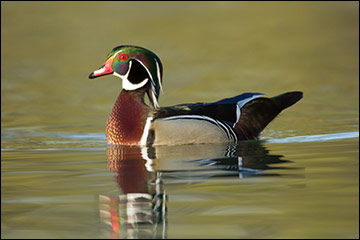 Figure 1a
Figure 1a
Male wood duck in its colorful breeding plumage. Males use these vibrant markings to attract females during the breeding season that runs from late autumn to early summer.
 Figure 1b
Figure 1b
Female wood duck with brood of young.
Range and Life History
The wood duck's breeding range extends over much of North America, from Nova Scotia west through Canada and from northern portions of the United States south to Florida and the Gulf of Mexico. Although wood ducks can be found year-round in southern Missouri, most migrate south in the fall and return to breed in February and March as temperatures warm. The first wood ducks that return to Missouri usually arrive in small flocks. In March and April, their statewide population is at its high point, as the spring migrants join birds that have stayed through the winter, and male and female pairs begin to nest. Table 1 shows the wood duck's annual life cycle.
Landowners can enhance wood ducks' nesting success and increase their local population by implementing certain habitat management practices on their property. Understanding the birds' biology and habitat needs is an important first step in attracting wood ducks to your property.
Table 1
Wood duck life history activities throughout the year.
| Activity | Jan. | Feb. | March | April | May | June | July | Aug. | Sept. | Oct. | Nov. | Dec. |
|---|---|---|---|---|---|---|---|---|---|---|---|---|
| Courtship and pairing | X | X | X | X | X | X | ||||||
| Fall migration to wintering habitat | X | X | X | |||||||||
| Spring migration to nesting habitat | X | X | ||||||||||
| Hens nesting | X | X | X | X | X | X | ||||||
| Post-breeding dispersal | X | X | X | X | ||||||||
| Males molting | X | X | X | X | ||||||||
| Hens molting | X | X | X |
Nesting and Reproduction
Wood ducks are the most common waterfowl species that nest in Missouri. They prefer to nest in hollow tree cavities. If hollow tree cavities are not available, the birds will nest in artificial cavities like nest boxes. Natural nest cavities are often located in mature trees in older forests and woodlands near water.
Male and female wood ducks will often initiate courtship activity and pair with one another in the fall and continue this activity through early spring. By March, males and females begin to select nesting sites. Although most sites are close to water, nesting cavities can be a half mile or more away. Wood duck hens will often return to the same nesting area each year. Once an appropriate site has been selected, the female begins nesting activities. Wood ducks have an extended nesting season of five to six months, particularly in southern Missouri. Due to the prolonged nesting season, males will often leave the hen well before the eggs have incubated and hatched and will often pair with late nesting or renesting females.
Because wood ducks do not bring in nest material, the cavity often contains some type of litter that forms a base. Hens usually lay one egg a day for 10 to 15 days and cover them with down feathers. The hen incubates the clutch, on average 10 to 15 eggs, for 28 to 37 days. Once the eggs hatch, the hen stays in the nest for about 24 hours until the young birds dry thoroughly. Once the ducklings are dry, usually the day after they hatch, the hen calls the brood from the nest and heads for water. The young birds climb out of the nest and jump to the water or ground. The female cares for the young and takes the ducklings to their brood rearing habitat (Figure 2).
The first few days and weeks after hatching are difficult for young birds. Mortality rates are high, mostly due to predation from turtles, snakes and bass. Travel across land can be hazardous, too, if the nest is away from water. Only three to four ducklings from a brood usually survive to the flying stage. One brood a year is typical, but two can occur.
The young ducks mature quickly. Ducklings remain covered with down for two to three weeks. By 6 weeks of age, they are fully feathered and can fly between 8 to 10 weeks of age. By then, the adult hens and their young separate, and adults begin molting. The adult birds cannot fly for about three weeks until their flight feathers grow back. They avoid predators such as snakes, opossums and raccoons by staying on the water and in thick woody and shrubby areas. Most birds are able to fly by late July to mid-August. By mid-October, males will once again be wearing their bright, colorful plumage, and the annual cycle begins again. Few birds live beyond three or four years. Young that have hatched the previous spring typically make up about 70 percent of the fall population.
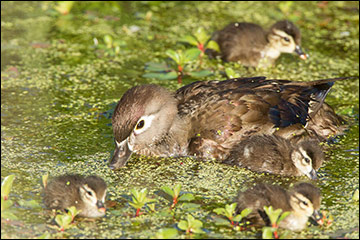 Figure 2
Figure 2
Female wood duck and ducklings feeding.
Habitat Requirements
Food, Cover, Water and Space
Wood duck wintering and breeding habitat is found in many forested locations near water. These habitats often include a mix of leafy plants, shrubs and trees associated with bottomland hardwoods, wooded sloughs and riparian areas along stream banks. The seasonal or long-term fluctuations of water in these habitats influence what plants exist and when food resources may be available to foraging wood ducks at different times of the year. Although wood duck brood-rearing and molting habitat can occur along streams, it also includes emergent marshes and shrub swamp habitats where the water and vegetation provide cover from predators (Figure 3).
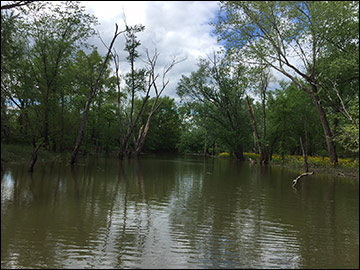 Figure 3
Figure 3
Example of flooded timber and wetland habitat.
Foods
Wood ducks meet their nutritional needs throughout the year by eating a variety of plants and animals in flooded forest and wetland habitats. The flowers and fruits of trees and shrubs, such as the samaras of maple trees, provide important food sources during the spring. Invertebrates, including crayfish, also make up much of their diet during late spring and summer months and provide the protein that hens need during egg laying and ducklings need after hatching.
Water depth is a key factor impacting the availability of foods. Shallow water is important in wood duck habitat because the birds seldom feed in water that is more than 18 inches deep. Plants that are rooted in soil and grow in shallow water, referred to as emergent plants, are important for growing ducks as they attract many aquatic insects, an important source of protein and the majority of wood duckling diets.
Aquatic plants that grow in shallow water, such as smartweeds, rushes, duckweed, pickerel weed and sedges, also provide important food and cover for wood ducks. Wood ducks also use plants such as cattails, water lilies and water primroses; however, these species will often take over an area and become difficult to manage.
Flooded lowland forests with abundant mast trees, such as oaks and hickories, also are a vital food source throughout the year, particularly during fall and winter. Acorns from red oak species — such as nuttall, pin, cherrybark and willow oak — are a high energy food source this time of year. Seeds from bald cypress, buttonbush, elms, maples and emergent plants are also important food sources.
Native wetland vegetation provides the nutrients and protein that young wood ducks need to grow. Wood ducks will also take advantage of agricultural crops such as corn, grain sorghum, buckwheat, and soybeans, as well as browntop, dove proso, foxtail and pearl millet.
Cover for Nesting
Wood ducks require cavities for nesting and use natural hollows in tree trunks and artificial nest boxes as nest sites (Figures 4a and 4b). Wood ducks usually nest near wetlands, rivers and other suitable aquatic environments; however, wood ducks may find and use nest cavities that are up to 1 mile away from water.
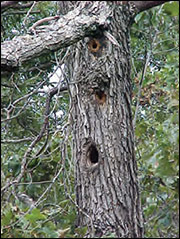 Figure 4a
Figure 4a
Natural nest cavity in a hollow tree trunk.
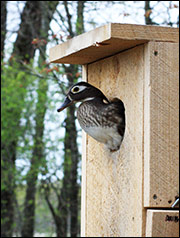 Figure 4b
Figure 4b
Wood duck boxes provide artificial cavities used for nest sites.
Nest cavities
Mature trees in or near forested wetlands provide important habitat with the natural tree cavities wood ducks use for nesting. Bald cypress, black tupelo, sycamore and ash trees predominate in lowland areas; oaks, elms and basswood are common in drier areas.
Natural cavities are often found 30 feet up in the tree canopy. The most suitable cavities are about 24 inches deep with an entrance hole of about 4 inches and an inside diameter of 6 to 8 inches. Because most natural cavities may not be suitable for nesting, efforts should be made to maintain as many mature trees within a habitat as possible. When there are not enough natural cavities, artificial nesting boxes can be used to enhance wood duck habitat.
Nest boxes
One of the best ways to attract wood ducks to your property is to provide nest boxes where there is a shortage of suitable tree cavities. Through years of research examining wood duck preferences, biologists have determined that the best boxes are built from weather resistant wood such as cedar or cypress.
Paint, stain or treat the outside of the box to make it more weather resistant. The entrance hole should have a 4 inch diameter or a 3-inch high and 4-inch wide oval. Attach a wire screen to the inside of the box up to the entrance hole to give the ducklings traction. Because the female does not bring nesting materials into the nest, add 3 to 4 inches of wood chips or sawdust to all boxes. Many nest box designs have been used with great success.
Predators such as raccoons, rat snakes, fox squirrels, woodpeckers and starlings often destroy wood duck nests, impacting their population. Most nest box designs include a cone-shaped predator guard of galvanized sheet metal on the post below the box. Use these guards whenever possible to deter common predators like raccoons. See Resources for more instructions and designs for building wood duck nest boxes.
Place nest boxes in the shade on an isolated tree or on a 16-foot-long, 4-by-4-inch metal or wooden post made of cypress, cedar or pressure-treated pine. As a general rule, place boxes over water about 5 to 10 feet above the water surface. When placing nest boxes over water, be sure to consider the area's flooding history and, if applicable, high-water mark. In some floodplains, placing the box at a 5-foot height will suffice; in others, the box may need to be at a 15 to 20 feet height so that they are not inundated during large floods.
Because wood ducks are secretive in selecting nest sites, boxes should be about 300 to 400 feet apart and not visible to one another. This will help reduce the incidences of dump nesting discussed earlier.i
If nest boxes cannot be placed over water, they should be no farther than a half mile from a permanent water source. You can also place boxes on trees growing on a sloping hillside next to a stream at a height that is above floodwater. Check and repair boxes each year during fall and winter. If more nesting material is needed, add it at this time (Figure 5).
Nest boxes made of wood often need to be maintained or replaced. Materials like plastic, fiberglass and metal also are used to reduce maintenance and replacement costs and predation. Always place boxes made of these materials in shaded areas. Particularly during a warm spring, these boxes can heat up and damage eggs.
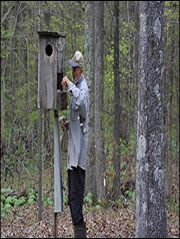 Figure 5
Figure 5
Check and maintain wood duck boxes each year so ducks will use them for nesting.
Cover for Brood Rearing
Wood ducks also need brood habitat and protective cover for young molting ducks to screen them from predators. Throughout late spring, summer and early fall, wood ducks use shrubby cover, such as buttonbush and willows, that are often found next to or interspersed in seasonally flooded areas like emergent marshes and shrub swamps. The ideal habitat consists of a mixture of tree canopy, shrubby cover, emergent wetland plants and open water. This reduces the risks of predation and increases ducks' access to adequate food resources. Quality brood habitat typically consists of a ratio of 50 to 75 percent vegetation and 25 to 50 percent open water. The ducks also will use other habitats if preferred habitats are not available. However, large open lakes or reservoirs without cover provide poor habitat for wood ducks.
Managing habitats for wood ducks
Quality wood duck habitats include food sources, water and cover for nesting and brood-rearing in close proximity. These components are typically found in forested wetlands, emergent marshes, shrub swamps and riparian areas next to streams and other water environments. These birds and habitats can exist in urban wetlands and stream areas, too.
Whether large or small in acreage, your property can offer quality wood duck habitat. The most important steps are to protect trees with cavities that provide nesting locations and to install artificial boxes if natural cavities are in short supply. Make sure there is adequate brood cover nearby, if possible. Wood ducks also may nest in upland areas that are not next to permanent water and brood cover. This means that landowners without a wetland or water source such as a pond or stream can improve habitat and attract wood ducks, as well. Table 2 provides a summary of management techniques you can implement on your property to provide habitat that wood ducks need.
Consult with private lands conservation professionals with the Missouri Department of Conservation or with wetland biologists with the U.S. Department of Agriculture Natural Resource Conservation Service. Financial assistance and technical expertise is available. There are also several wetland habitat incentive and cost-share programs that you may be able to use to help improve wood duck habitats on your property.
Contact your MU Extension center for more information on managing your property for wood ducks, as well as other wildlife species that may be of interest.
Table 2
Habitat components required by wood ducks and a summary of management practices that can be implemented on your property.
| Habitat component | Habitat requirement | Management techniques to implement |
|---|---|---|
| Foods | Insects and aquatic invertebrates, small fish Oak acorns and seeds of bald cypress, sweet gum, button bush, hickories, maple samaras and other mast producing plants Aquatic plants and seeds |
Protect and conserve shallow water areas and wetland habitats Plant and maintain trees, shrubs and herbaceous food plants Seasonally manage water levels of different habitats to provide food and habitat needs for different life stages Shallowly flood emergent marshes and shrub swamps in spring, summer and fall. Shallowly flood bottomland hardwoods after leaves drop and trees are dormant. Drain area prior to leaf-out in spring |
| Nesting cover |
Natural tree cavities or artificial nest boxes placed in deciduous woodlands adjacent to streams, creeks, wetlands, ponds, rivers, and other suitable habitat used for rearing broods |
Install artificial nest boxes Establish woody riparian vegetation along aquatic habitats Maintain mature cavity producing trees adjacent to aquatic habitat or in close proximity to these areas for nesting |
| Brood rearing cover | Shallow water areas such as along streams, emergent wetlands and shrub swamp habitats that contain food and protective cover from predators A ratio of 50 to 75 percent cover to 25 to 50 percent open water is preferred to provide habitat attractive to invertebrates that foraging birds eat |
Restore the hydrology and recreate wetlands on areas that have been previously drained Establish and manage for shrubby cover and emergent and thick woody vegetation along streams and other aquatic environments |
| Winter cover | Emergent marshes, shrub swamps, and bottomland hardwoods that provide an adequate overhead canopy | Restore the hydrology and recreate wetland habitat on areas that have been drained Gradually provide shallow water (<2 feet deep) throughout the winter on crops, shrub swamp, emergent wetlands or forested bottomlands |
|
Water |
Water requirements are met in locations that serve as quality brood-rearing habitat |
Restore the hydrology and recreate wetland habitat on areas that have been drained |
Portions of this information have been adapted from USDA NRCS Fish and Wildlife Management Leaflet "Wood ducks."
Programs that provide technical and financial assistance for developing wildlife habitat on your property are available. Contact the USDA Natural Resources Conservation Service in Missouri for more information.
Resources
- Ducks Unlimited, Wood duck boxes
- Fredrickson, L. H., G. V. Burger, S. P. Havera, D. A. Graber, R. E. Kirby, and T. S. Taylor, editors. 1990. Proceedings of the 1988 North American Wood Duck Symposium, St. Louis, MO, February 20-22, 1988
- National Audubon Society, Wood duck nest box plans
- U.S. Department of Agriculture Natural Resources Conservation Service, Missouri
- U.S. Fish and Wildlife Service, Life history and habitat needs of the wood duck, Fish and Wildlife Leaflet 13.1.6. Waterfowl Management Handbook (PDF)
Photo credits
Robert A. Pierce II, Frank Nelson, Missouri Department of Conservation
Acknowledgement
This publication is dedicated to Dr. Leigh H. Fredrickson, retired professor with the University of Missouri's Gaylord Memorial Wildlife Research Laboratory in Puxico, Mo., whose 40-plus years of waterfowl and wetlands research has provided the basis of knowledge of wood duck ecology and habitat management in Missouri.